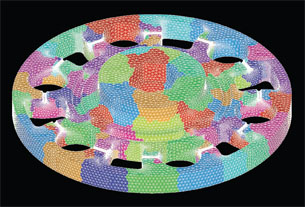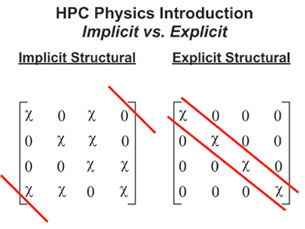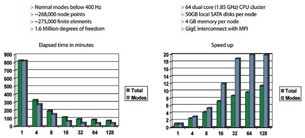Scaling New Heights in a Perfect HPC Storm, 1 in a Series
High-performance computing, CAE technology, and data management are converging to a point where scaling is poised to make all the difference.
Latest News
November 1, 2008
By Tom Kevan
Pages 1 | 2 »
 Figure 1: Parallel processing divides a model into small domains. Here, the colored regions are subdomains that are distributed among the individual cores of the cluster for analysis. A single domain or many domains can be placed on individual cores, depending on the application. To be effective, the domains must be solvable as individual pieces. (Image courtesy of ANSYS Inc.) |
Parallel processing — the simultaneous use of more than one CPU on a single application — is one of the key advantages of cluster-based high-performance computing (HPC) systems. In theory, the more processors in a cluster, the faster the system can solve a problem.
To take advantage of this feature, CAE software must be able to scale. In other words, the software must be able to break the problem down into smaller and smaller pieces and then distribute those application components among the individual computing processors (see Figure 1, right).
Parallel processing on these systems has enabled engineers to take on bigger problems and do more detailed simulations than they could in the past, so the potential of this functionality has become a driving force in the software community.
“Multi-core systems have upped the ante,” says Barbara Hutchings, director of partner relations at ANSYS. “It’s made parallel processing more available to our customers and increased the pressure on software vendors to ensure that we’re doing everything we can to keep the scaling story improving over time.”
At this stage of the technologies’ development, however, it’s important to keep in mind that not all types of CAE software scale equally well. The ability of the various flavors of software to scale is determined by a number of factors, such as the mathematical formulations used, complexity of the application, and level of interprocessor communications.
Doing the Math
The numerical solution schemes of CAE software fall into two categories: implicit and explicit. When dependent variables are defined by coupled sets of equations and either a matrix or an iterative approach is required, the numerical solution is implicit. When the variables are defined in terms of known quantities, the approach is considered explicit.
 Figure 2: The equation matrix for implicit structure analysis is a sparse matrix (it is populated primarily with zero coefficients). However, the remaining terms are not diagonal, which therefore require a form of Gaussian elimination or direct method to solve. The explicit form does not require Gaussian elimination and is easier to implement. (Image courtesy of ANSYS Inc.) |
For example, finite element analysis (FEA) software uses both mathematical approaches. In an implicit solution scheme, you build a large finite element model represented by large matrices, which can consist of tens of millions of rows and columns. These matrices represent the behavior of parts and assemblies of the parts in an operating environment. If you have a complete aircraft structure, its parts are represented mathematically by large matrices. If you apply a load or any kind of operating condition on a part, the mathematical formulation can determine the response to the operating conditions.
Explicit technology uses different mathematics. In this type of solution scheme, you have small-element, localized matrix problems that you have to solve as you go along (see Figure 2, left). This type of software is used primarily to describe short-duration events, such as those found in impact or crash analysis.
Most mainstream FEA software relies on implicit mathematics, but in some cases, when you’re solving time-dependent, nonlinear problems, you use explicit methods. By and large, FEA software is built on implicit codes, which do not scale as well as software using the explicit approach. “Generally speaking, the algorithms and mathematics used in explicit software scale somewhat better than implicit software,” says Peter Mendoza, director of solutions marketing at MSC.Software.
The mathematics used by a CAE software program has a definite effect on its scalability. It is, however, neither the sole determining factor nor the primary influence. Even more important is the complexity of the application.
Degrees of Freedom
Not all types of CAE software scale equally well. One reason for this is the fact that the physics involved in each discipline do not have the same degree of difficulty. This can be seen in the meshing process, when the software discretizes a continuous domain into a set of discrete sub-domains, called elements.
 Figure 3: This normal mode analysis (natural frequency calculation) of a car body model wit Subscribe to our FREE magazine, FREE email newsletters or both!
Join over 90,000 engineering professionals who get fresh engineering news as soon as it is published.
Latest NewsInnovMetric Releases PolyWorks 2024
Endeavor 3D Integrates Materialise’s CO-AM with HP Tech
Tech Soft 3D Buys Actify SpinFire Business
View a Live XR Broadcast in Apple Vision Pro?
Investing in Success: How Training Programs Shape a Culture of Employee Retention
Mercedes-Benz Funds Educational Initiatives in AI, Automated Driving at Universities
All posts
About the AuthorDE’s editors contribute news and new product announcements to Digital Engineering. #8975
New & Noteworthy 
New & Noteworthy: Safe, Cost-Effective Metal 3D Printing - Anywhere
Desktop Metal’s Studio System offers turnkey metal printing for prototypes and...

New & Noteworthy: Direct Neutronics Analysis on CAD
Coreform Cubit 2023.11 workflows enable neutronics directly on CAD for next-generation nuclear energy...

New & Noteworthy: Agile Engineering Collaboration
Authentise Threads is a new software tool for distributed communications and project...

New & Noteworthy Product Introduction: Enterprise VR Headset
Lenovo ThinkReality VRX has an immersive display works with virtual, augmented and...
|


